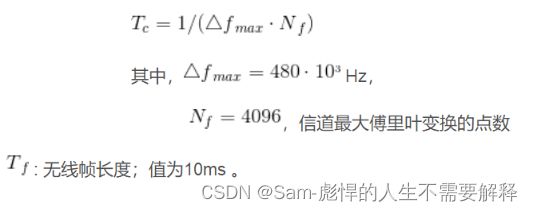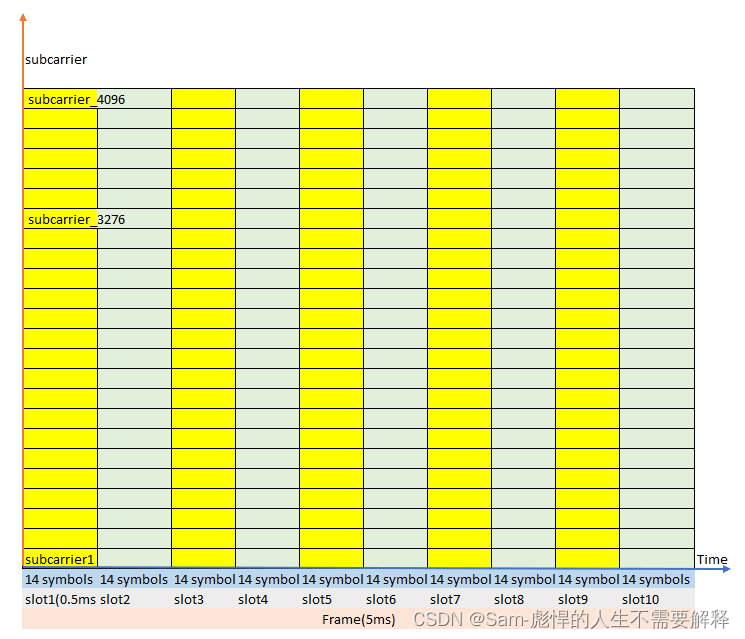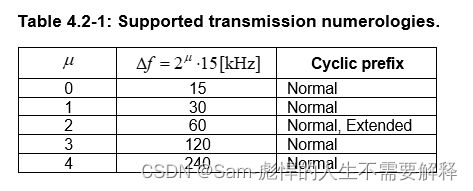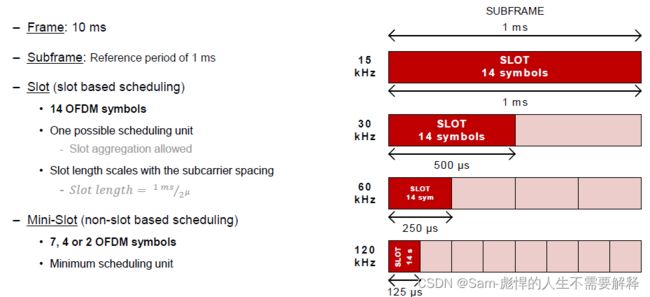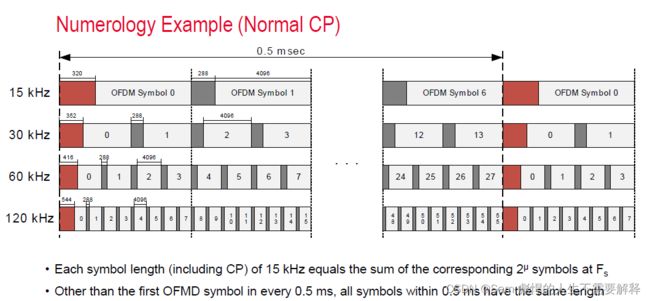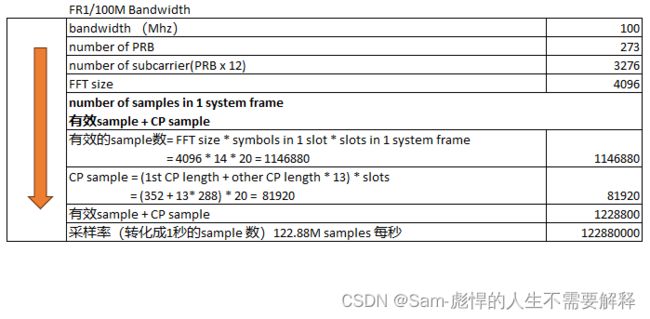5G_带宽与采样率(二)
100M 带宽是122.88Mhz sampling rate这是我们都知道的,那它是怎么来的呢?
第一种方式:采样率= 子载波间隔 * 采样长度
我们先看看38.211中对于Tc的定义, 在LTE是定义了Ts,在NR也就是5G定义了Tc。
定义这个单位会对我们以后工作中的计算至关重要,以后我们慢慢讲。
delta Fmax = 480*1000 hz就是在FR2中定义的最大子载波间隔。
Nf = 4096又是怎么来的呢?
根据3GPP NRB(number of PRB),我们知道100M带宽(SCS 30KHZ) 有273个PRB
那也就以为着 273*12= 3276个subcarrier, 在频域上至少要采样3276个点才能搜集到完整的信号
同时我们也知道采样深度必须是 2 的倍数那只能选用4096,而subcarrier spacing 是30Khz。
所以最后 100M的sampling rate(采样率) = 4096 * 30000 = 122.88Mhz
Table 5.3.2-1: Transmission bandwidth configuration NRB for FR1
| SCS (kHz) |
5 MHz |
10 MHz |
15 MHz |
20 MHz |
25 MHz |
30 MHz |
35 MHz |
40 MHz |
45 MHz |
50 MHz |
60 MHz |
70 MHz |
80 MHz |
90 MHz |
100 MHz |
| NRB |
NRB |
NRB |
NRB |
NRB |
NRB |
NRB |
NRB |
NRB |
NRB |
NRB |
NRB |
NRB |
NRB |
NRB |
|
| 15 |
25 |
52 |
79 |
106 |
133 |
160 |
188 |
216 |
242 |
270 |
N/A |
N/A |
N/A |
N/A |
N/A |
| 30 |
11 |
24 |
38 |
51 |
65 |
78 |
92 |
106 |
119 |
133 |
162 |
189 |
217 |
245 |
273 |
| 60 |
N/A |
11 |
18 |
24 |
31 |
38 |
44 |
51 |
58 |
65 |
79 |
93 |
107 |
121 |
135 |
第二种方式:所有有用的和没用的数据加起来的总和
思考一下我们需要什么样的采样的速率:使用尽量低的采样速率把所有的数据能够完整的获取。
看一下这个图,我们还是以NR、 100M、SCS 30Khz最例子, normal CP
那么我们的采样速率需要满足:
1. 频域上:采样到每个subcarrier,同时为了满足2 ^ n ,那么就不是刚好3276 而是4096
2. 时域上:需要获取到每个symbol 并别在symbol 前面的CP也需要采样
物理层资源分配基本概念
在介绍具体计算之前,讲讲物理层资源分配基本概念
最小资源块(resource element)3GPP 38.211 4.4.3 Resource elements
Each element in the resource grid for antenna port p and subcarrier spacing configuration μ is called a resource element and is uniquely identified by (k,l)p,μ where is the index in the frequency domain and refers to the symbol position in the time domain relative to some reference point. Resource element (k,l)p,μ corresponds to a physical resource and the complex value ak,l(p,μ) . When there is no risk for confusion, or no particular antenna port or subcarrier spacing is specified, the indices p and μ may be dropped, resulting in ak,l(p) or ak,l .
从3GPP 可以看出RE的最小资源块,就是用来承载我们传输的数据(信息)横坐标是一个symbol,纵坐标是一个subcarrier
Frame Structure
Multiple OFDM numerologies are supported as given by Table 4.2-1 where μ and the cyclic prefix for a bandwidth part are obtained from the higher-layer parameter subcarrierSpacing and cyclicPrefix, respectively.
定义了normal CP / subcarrier 30Khz时μ 等于1,那么1个slot 的长度是5ms(LTE 15的subcarrier就是1ms = 1 slot)
CP length(FFT size)
我们已经知道了一个system frame(10ms) 中有多少slot, 每个slot中有多少有效symbol,
那么我们怎么去采样symbol 前面的 CP(cyclic prefix)?(有空我们再讲讲为什么需要在每个symbol前面加上个CP)
3GPP 38.104 B5.2 中对EVM window length的定义,有关于CP length的定义(FR1(sub6G) / NR 100M/30Khz subcarrier/ normal CP为例子)
如下图我们知道每个slot中14个symbol的第一个symbol的长度和其他13个CP是不一样大的
通过计算我们知道了1st CP lenght 是352 samples , the others是 288 samples,为什么单位是sample可以思考一下
| CP length calcualtion | Samples |
| CP length for symbols 1‑13 in FFT samples | 288 |
| FFT size | 4096 |
| 1st CP length = FFT size -13 x CP length of 1-13 1st CP length = 4096 - 13 x 288 = 352 |
352 |
下面我们就可以开始计算了
pre-condition
- FR1 sub6G
- 100Mhz 带宽
- subcarrier 30Khz
- normal CP
从上往下看我们就知道了100M带宽的采样率为什么是122.88M
